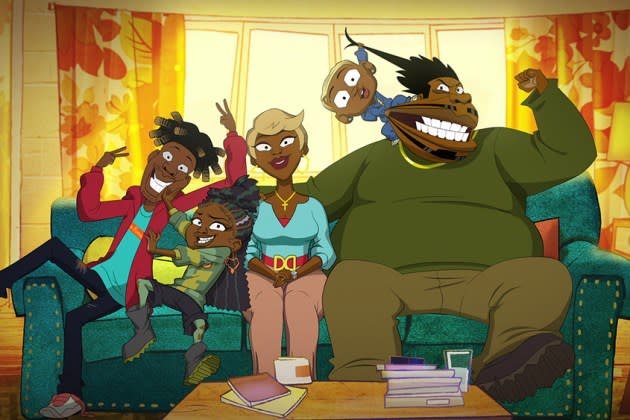NAACP Reacts to ‘Good Times’ Trailer: “Choices Were Made and Approved” (Guest Column)

Shortly after Netflix released the trailer for its new adult animated series Good Times two weeks ago, our office started receiving calls and emails.
Inspired by the iconic live-action sitcom of the 1970s, the new show’s use of the beloved title conjures notions of familial fabric and community cohesion, amid challenges of generational poverty and stifling social policies that perpetuate inequitable caste conditions. Fans of the original series likely expected to see descendants of the Evans family engaging with their circumstances in adherence to the ancestral creed: Love through the pain.
More from The Hollywood Reporter
Hollywood Flashback: Norman Lear's 'Good Times' Rolled 50 Years Ago
'Bridgerton' Season 3 Trailer Teases a Polin Friends-to-Lovers Storyline
But to the considerable consternation of many viewers, the new Good Times trailer seems to establish a world of Black characters navigating chaos and dysfunction, largely driven by drugs, violence and discord. While sibling tension is a common dynamic within TV family portrayals, the trailer resolves such banter by offering a father’s regret for failing to employ prophylactic measures to avoid parenthood. A voiceover referencing patriarch James Evans’ dedication to providing for the family is then followed by the animated dad’s version of fatherhood: a threat to kill the [N-word] dating his daughter. When asked for advice on advancing son Junior out of a third term in the 10th grade, a school official suggests the young man launch a pornography site. The trailer also offers a rendering of a Black heavenly deity preoccupied with playing video games. But the most absurd portion of the two-minute and 43-second clip is its prominent presentation of a drug-dealing baby. We’re treated to images of the baby shooting dice on the street, lusting for breasts to suckle and ultimately engaging in a shootout with three other thuggish Black babies.
As a leading organization for social justice and civil rights, the NAACP was called on to take action and issue a response. In an effort to gain a more complete and clear understanding of the creative direction for the new series, executive produced by the late Norman Lear, widely recognized as the creator of the original, alongside basketball great Stephen Curry and Family Guy’s Seth MacFarlane, the NAACP requested screeners of full episodes. Netflix declined. So instead, we contacted creatives involved with the production and asked them about their vision and execution. We were told there was a deliberate effort to “push the envelope” in the storytelling and tonality. We were told about real-life events that informed the basis for certain episodic elements, and we were reminded that the mandate of the adult animation genre is to sensationalize and exaggerate realities.
It is true that animation is not confined by the limitations of physical or psychological properties. In cartoons, cars can fly, fish can sing and, apparently, babies can sell drugs. But we wonder whether the historical relationship between Hollywood and the Black community should create caution about the use of distorted imagery and narratives that further pervert the representation of a people.
Series personnel also shared that the show is framed by a recurring indictment of “the system” for creating and maintaining oppressive conditions that plague the Black community. In fact, the promotional trailer includes an articulation of that allegation: Unnamed white men, dressed in suits and sunglasses, drop off crates of automatic weapons in the ‘hood at night, as a voiceover explains, “The system puts the guns and drugs on the street.”
Perhaps an underlying social commentary counterbalances the imagery teased in the Good Times trailer. Perhaps the full episodes provide unique entertainment value while also challenging racist social policy. All will be evident when the series launches this Friday. What is clear today, however, is the choice made by Netflix to market the show based on an interpretation of Black life as an “otherized” experience, replete with abhorrent beliefs and behaviors.
Clips used in the trailer were culled from 10 episodes of content, a vast inventory of options available to fill the short clip used to market the show. Committees of people were involved in the search for proper balance between comedy, absurdity and social commentary. Choices were made and approved. The impact of the campaign probably exceeded expectations, as negative news travels fast and people seem to enjoy commiserating in their contempt. Perhaps that was the plan.
But to be clear, there’s nothing new here. Renderings of Black life in media often serve to buoy the artificiality of white supremacy, as the NAACP explores in our media guide. While we continue to engage with media institutions to encourage reform, we also call upon our constituents to develop greater discernment in their engagement. We must elevate our consciousness for media consumption. Keen awareness of the power and consequences of media will lead us to more informed choices and, in turn, lead the industry to make necessary adjustments. To the extent that media choices are designed to satisfy the need of others to be affirmed in their false sense of superiority, we call for more accurate portrayals of the truth, deeper dimension in the exploration of our humanity and exposure of the deliberate propaganda that supports our oppression.
After all, we want Good Times too.
Best of The Hollywood Reporter
A 'Star Wars' Timeline: All the Movies and TV Shows in the Franchise
'Star Wars': 16 Animated Characters Who Made the Leap to Live-Action
Power Showrunners: Hollywood’s 50-ish Most Influential Writer-Producers of 2023

